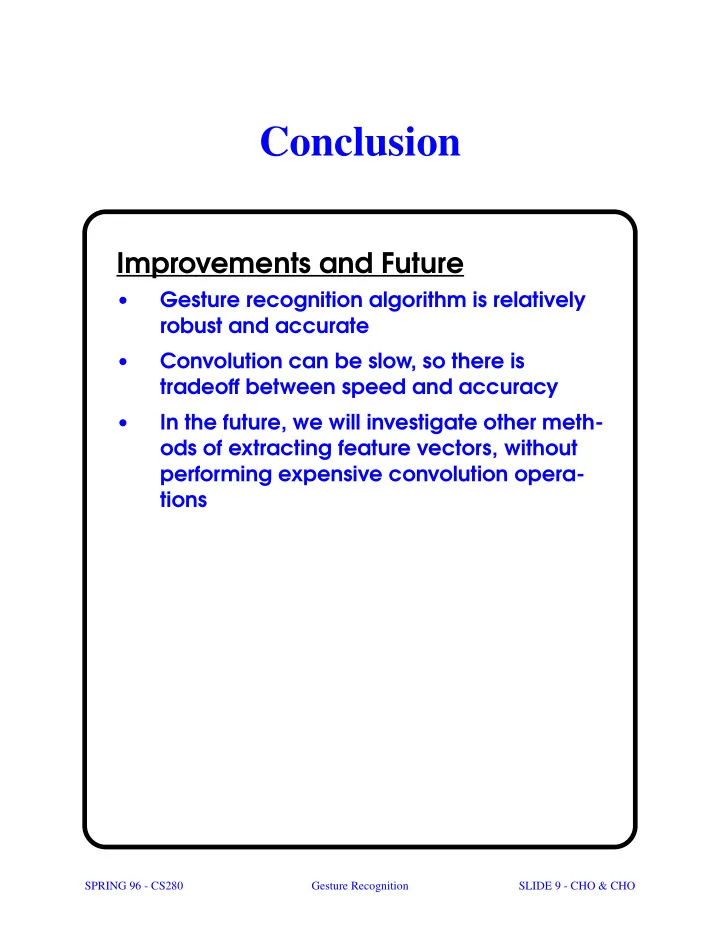

Conclusion Improvements and Future • Gesture recognition algorithm is relatively robust and accurate • Convolution can be slow, so there is tradeoff between speed and accuracy • In the future, we will investigate other meth- ods of extracting feature vectors, without performing expensive convolution opera- tions SPRING 96 - CS280 Gesture Recognition SLIDE 9 - CHO & CHO
Accuracy Measurement for Gesture Recognition HAND HAND A HAND B HAND A HAND A TYPES UNDER WITH ATTEMPT ATTEMPT LESS HAND A NO. 1 NO. 2 GESTURE LIGHTING TEMPLATE FORWARD 90% 70% 100% 74% RIGHT 96% 100% 72% 88% LEFT 60% 92% 50% 82% OPEN 86% 80% 72% 82% CLOSE 98% 100% 100% 96% AVERAGE 84.0% 88.4% 78.8% 84.4% Frame Rate: 0.4 frames per second SPRING 96 - CS280 Gesture Recognition SLIDE 8 - CHO & CHO
Virtual Reality Explanation Application • The user can interact with the virtual envi- ronment by hand gestures • The virtual hand mimics the gesture of the user’s hand • Hand Gesture Commands: Finger pointing up == Moves the virtual hand forward Finger pointing slant== Changes the direction of the virtual hand Closed Hand == Grab an object Open Hand == Release an object • In the initialization phase, the user supplies the template gestures. • During the recognition phase, the system matches the sample against the template gestures. SPRING 96 - CS280 Gesture Recognition SLIDE 7 - CHO & CHO
Application 2 of 2 (4) Up Forward (5) Open Hand Release (6) Upper Left Turn Left SPRING 96 - CS280 Gesture Recognition SLIDE 6 - CHO & CHO
Application 1 of 2 (1) Up Forward (2) Close Hand Grab (3) Upper Right Turn Right SPRING 96 - CS280 Gesture Recognition SLIDE 5 - CHO & CHO
Composite Imaging Explanation Composite Image Explanation • We calculated the local orientations at 0, 45, 90 and 135 degrees by convolving the image with appropriate 2-D Gaussian derivative filters. • We used threshold to eliminate the back- ground noise • In the figure: Grey == Background White == Local Orientation of 0 Degree Red == Local Orientation of 45 Degrees Green == Local Orientation of 90 Degrees Blue == Local Orientation of 135 Degrees • The Orientation Histogram is derived by counting the white pixels, red pixels, etc. • Classification by finding the nearest neigh- bor with the smallest Euclidean distance to the sample SPRING 96 - CS280 Gesture Recognition SLIDE 4 - CHO & CHO
Composite Image ORIGINAL IMAGE COMPOSITE VERTICAL 45 DEGREES HORIZONTAL 135 DEGREES SPRING 96 - CS280 Gesture Recognition SLIDE 3 - CHO & CHO
Motivation and Recognition Motivation • The user can interact with the virtual envi- ronment using hand gestures. • No Special Hardware Necessary, except for the Camera. • No Special Hand Markings Necessary Recognition We wanted a recognition algorithm that is: • Relatively simple and fast, which can run in real-time on a workstation • Robust against changing lighting condi- tions • Translation Invariant • Maintain accuracy, even when different hands are used We decided to use orientation histogram as the feature vector for gesture classification, since it SPRING 96 - CS280 Gesture Recognition SLIDE 2 - CHO & CHO
Virtual Reality Simulation using Hand Gesture Recognition by Young Cho and Franklin Cho SPRING 96 - CS280 Gesture Recognition SLIDE 1 - CHO & CHO
Recommend
More recommend